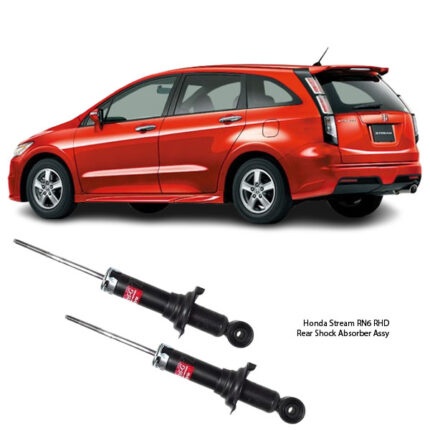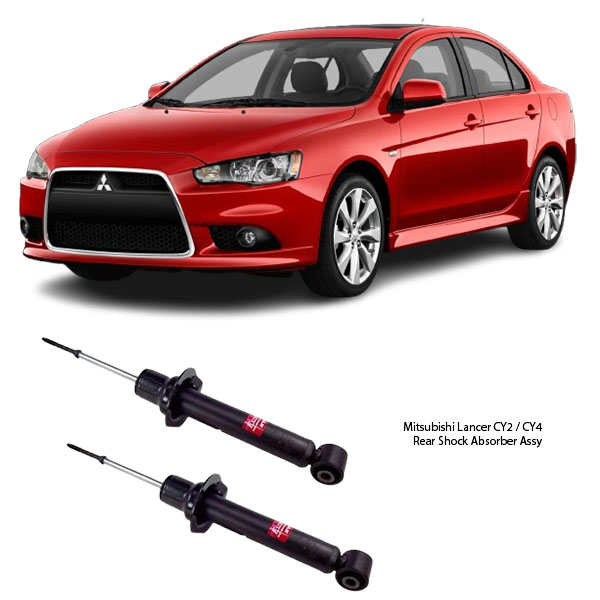-8%
Get Mitsubishi Lancer CY4 Rear Shock Absorber Assy 341455 in Kenya
When we think about vehicle safety and comfort, the rear shock absorber assembly (Assy) is often an overlooked yet essential part of a vehicle’s suspension system. Located in the rear of a vehicle, this component plays a critical role in absorbing the shocks from bumps, potholes, and rough terrain, ultimately ensuring that the ride remains smooth, stable, and safe.
In this article, we will dive into the essential aspects of the Rear Shock Absorber Assy, covering its function, design, common issues, and the importance of proper maintenance.
What is a Rear Shock Absorber Assy? 🛠️
A rear shock absorber assembly (Assy) is a key component in a vehicle’s rear suspension system. It works by controlling the movement of the vehicle’s suspension springs, reducing the bounce and oscillations that happen when the vehicle encounters bumps or rough road conditions. Shock absorbers are designed to absorb and dissipate the energy from these impacts, preventing the vehicle from bouncing or swaying excessively.
The rear shock absorber assembly typically consists of a shock absorber, which is a hydraulic or gas-filled cylinder, and additional components such as mounting brackets, bushings, and bolts that ensure the shock absorber stays in place. The shock absorber is often paired with other suspension elements like coil springs or leaf springs to form a comprehensive suspension system that works in harmony to improve ride comfort and vehicle stability.
How Does a Rear Shock Absorber Work? ⚙️
The primary function of a rear shock absorber is to control the movement of the suspension and to dampen the forces that affect the vehicle. When the suspension compresses (such as when the car drives over a bump), the shock absorber resists that compression and slows down the upward movement. When the suspension rebounds (returns to its normal position), the shock absorber slows the movement to prevent excessive bouncing.
The internal mechanism of the shock absorber typically involves a piston moving inside a cylinder filled with hydraulic fluid or gas. When the suspension moves, the piston forces the fluid through small holes or valves, which create resistance. This resistance controls the speed at which the suspension compresses and rebounds, ensuring smooth and controlled movements of the vehicle’s body.
The Role of Rear Shock Absorbers in Vehicle Performance 🚙
1. Improving Ride Comfort 🌟
Rear shock absorbers are crucial for improving the comfort of the ride. Without them, the vehicle would bounce and sway excessively when encountering uneven road surfaces. The shock absorbers absorb the impact and prevent the body of the vehicle from moving too much, reducing the discomfort that would otherwise be felt by the passengers. A well-functioning rear shock absorber ensures a smooth and comfortable journey.
2. Enhancing Vehicle Stability and Control 🚗
In addition to providing comfort, rear shock absorbers enhance the overall stability and control of the vehicle. They help maintain the tire’s contact with the road by preventing excessive body movement, which is particularly important when driving over bumps, during sharp turns, or when braking. When the rear shock absorbers are functioning properly, they help the vehicle maintain traction, improving both safety and handling.
3. Reducing Wear and Tear on Other Suspension Components 🔧
The shock absorber assembly doesn’t only protect passengers—it also helps protect other suspension components. By absorbing the impacts from bumps and rough terrain, the shock absorber prevents these forces from being transferred to other parts of the suspension system, such as the springs, control arms, and bushings. This reduces wear and tear on these components, prolonging their lifespan and maintaining the overall integrity of the suspension system.
4. Preventing Bottoming Out 💥
When the shock absorber fails, it can lead to the suspension system “bottoming out” (when the vehicle’s suspension reaches its limit of travel and the suspension components hit the chassis). This results in a rough ride, and it can potentially damage the suspension and other vehicle components. A well-functioning rear shock absorber prevents bottoming out by controlling the compression and rebound movements of the suspension.
Common Symptoms of a Faulty Rear Shock Absorber 🛑
Over time, rear shock absorbers can wear out or fail, affecting the ride quality and safety of your vehicle. Here are some common signs that the rear shock absorbers may need replacing:
1. Excessive Bouncing 🚧
One of the most noticeable symptoms of a failing rear shock absorber is excessive bouncing or swaying of the vehicle. If the rear of the car feels bouncy or unstable when driving over bumps or dips, this could indicate that the shock absorbers are no longer absorbing the shock effectively.
2. Uneven or Worn Tires 🏎️
Worn-out shock absorbers can cause uneven wear on the tires. If the tires appear worn on one side or have bald spots, this may be a sign that the shock absorbers are not keeping the vehicle’s body level, causing uneven pressure on the tires.
3. Poor Handling 🚨
If the vehicle swerves, drifts, or feels unstable, especially during sharp turns or quick maneuvers, the rear shock absorbers may be to blame. Poor handling and loss of control can occur when the rear shock absorbers can’t stabilize the suspension properly.
4. Nose Diving During Braking 🚙💨
If the front of the vehicle dips significantly when applying the brakes (especially when braking suddenly), it could indicate that the rear shock absorbers are worn out. This is because the rear suspension is unable to provide adequate support when the vehicle’s weight shifts forward under braking.
5. Visible Leaks or Damage 🧽
Shock absorbers are filled with hydraulic fluid or gas, and over time, they may begin to leak. If you notice oil or fluid stains around the shock absorber or the area around the shock mount, it’s a clear sign that the shock absorber is damaged and needs replacing.
Replacing the Rear Shock Absorber Assy 🔧
Replacing the rear shock absorber assembly is a relatively simple process but requires some mechanical knowledge. Here’s a general guide on how to replace the rear shock absorbers:
1. Lift the Vehicle 🔝
First, ensure the vehicle is securely lifted using a jack, and support it with jack stands. You should also remove the wheels to access the shock absorbers.
2. Remove the Old Shock Absorber 🔩
The shock absorber will be attached to the vehicle at both the top and bottom. You’ll need to unbolt the top mount and the lower mounting bolts. In some vehicles, this may require removing additional parts for better access.
3. Install the New Shock Absorber 🔧
Once the old shock absorber is removed, install the new one in the same position. Ensure it is properly aligned and tightened at both the top and bottom mounts.
4. Reassemble and Test 🚙
Once the shock absorber is securely installed, reattach the wheel and lower the vehicle. It’s a good idea to test drive the vehicle to ensure that the suspension is functioning properly, and the ride is smooth.
Conclusion: The Importance of the Rear Shock Absorber Assy 🚗💪
The Rear Shock Absorber Assy plays an essential role in the comfort, safety, and performance of your vehicle. It helps maintain vehicle stability, improves ride quality, reduces wear on other suspension components, and ensures a smooth and controlled driving experience. Over time, shock absorbers can wear out, leading to poor handling, decreased comfort, and even safety hazards. Therefore, it’s crucial to maintain and replace them when necessary.
If you notice any signs of a failing rear shock absorber—such as excessive bouncing, poor handling, or uneven tire wear—it’s essential to have it inspected and replaced as soon as possible. Regularly replacing shock absorbers can prolong the life of your vehicle’s suspension system and ensure a safer, more enjoyable driving experience.
Follow us on Facebook for more parts.




Reviews
Clear filtersThere are no reviews yet.